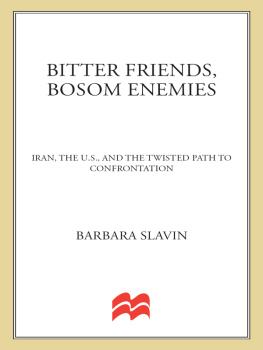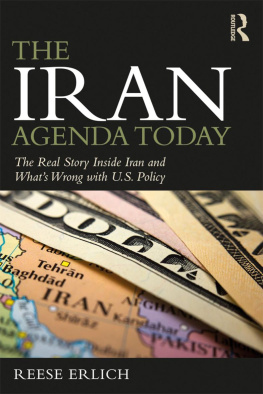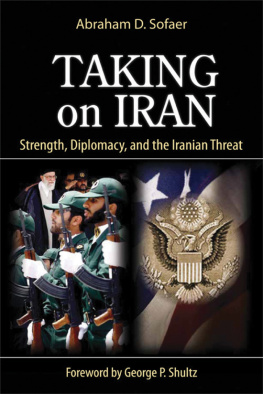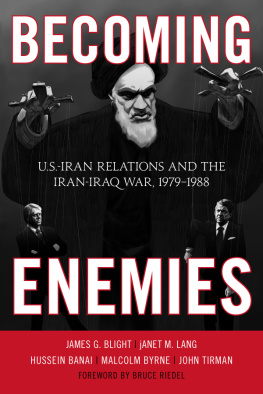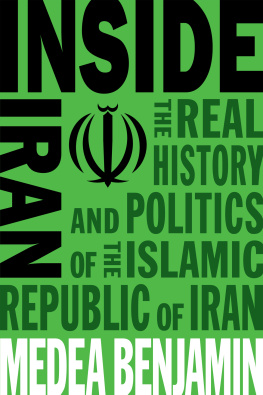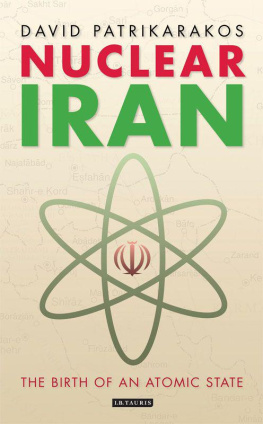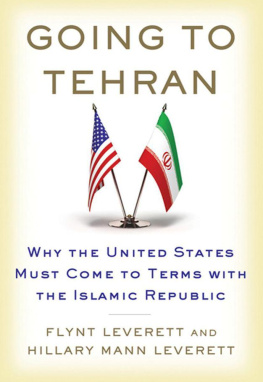Acknowledgments
T HIS BOOK WOULD NOT have been written if not for Haleh Esfandiari, an Iranian-American scholar whose wisdom and warmth have inspired me for more than a decade. It was Haleh, who runs the Middle East program at the Woodrow Wilson International Center for Scholars, who first suggested that I write a book after I returned to Washington from my sixth visit to Iran in February 2006. She read the manuscript in various stages, gave sage advice, and made crucial corrections. I thank her and her husband, Shaul Bakhash, for their friendship and counsel. (Haleh was arrested May 8, 2007, and taken to Evin prison in Tehran after four months of de facto house arrest at the home of her elderly mother. It is my fervent hope that she will have been freed long before this book is published.)
Mike Van Dusen and the entire staff at the Wilson Center, from President Lee Hamilton to the library and administrative personnel and the security guards at the front desk, made me feel at home and gave me the intellectual and physical space necessary to find my voice after years of daily journalism. The Wilson Center also provided an enthusiastic research assistant, Megan Gattuso, who provided significant help.
There are many others who contributed to this book, in Iran and in the United States. Among them are Yahyia Fiuzi, an Iranian-American architect, and his beautiful and talented daughter, Pani Farkhan, who have promoted the best in both societies. Goli Emami and her late husband, Karim, made me feel at home far away from home and touched me with their intelligence and passionate concern for their country and their culture. Hadi Semati, a professor of political science at Tehran University, has enlightened countless Americans about Irans complicated politics and patiently interrupted his own work at the Wilson Center to answer my unending questions. Irans outgoing ambassador to the United Nations, Mohammad Javad Zarif, and former ambassador to France, Sadegh Kharrazi, provided thoughtful analysis, as did several European envoys in Tehran who, for diplomatic reasons, asked to remain nameless.
I also want to thank all my various fixers/translators, some of whom also requested that I not identify themeven though the Iranian government undoubtedly knows who they are. I particularly thank Reza, the staff of the Baztab Web site, and Leily Lankarani. Leily was with me during my interviews with President Ahmadinejad and former President Rafsanjani, and was as much colleague and friend as translator. Ebrahim Mahmoody has been my driver and companion on all my trips to Iran. He is the first person I see when I get out of the airport terminalstanding patiently with a bouquet of red rosesand the last person to say good-bye before I fly home. I cant imagine Iran without him.
On the U.S. side, Kenneth Katzman at the Congressional Research Service is perhaps the best analyst of Iran who has never gotten to travel there (a situation that I hope will be rectified). I particularly appreciate his help on the subject of the Revolutionary Guards. Vali Nasr is an outstanding scholar of Iran and Shiism and was a great source of information and encouragement. Trita Parsi, William Miller, Karim Sadjadpour, and Patrick Clawson also provided helpful details and analysis. Colin Powell, Brent Scowcroft, Richard Haass, Richard Armitage, Martin Indyk, Bruce Riedel, Flynt Leverett, and Hillary Mann are among the former U.S. officials who shared their experiencesand frustrationsin formulating U.S. policy toward Iran. I appreciate as well the access granted to me by Secretary of State Condoleezza Rice, her undersecretary for political affairs, Nick Burns, and former Iraq ambassador Zalmay Khalilzad, and the assistance of other serving U.S. diplomats who disclosed crucial details about Bush administration policy but asked that I withhold their names to avoid prejudicing their careers.
My agent, Gail Ross, taught me how to write a book proposal and extracted a first chapter sufficient to attract St. Martins Press and its executive editor, Michael Flamini. Thanks to Michael and his staff, the publishing process has been far more pleasure than pain. Geraldine Brooks, the Pultizer Prizewinning author of March, is a colleague from the days when we were both foreign correspondents based in Cairo. She was kind enough to read the manuscript and to recommend it to you, the reader.
My husband, Michael Ross, our son, Andrew, and my closest woman friend, Deirdre Carson (alias Didi), provided encouragement throughout the writing process. Michael read several versions of the book and made many good suggestions; Andrew, who is turning out to be a better writer than either of his parents, also read much of the first draft and subsequent drafts, as did Didi. For their dedication to me, this book is dedicated to them.
Introduction
M Y FIRST GLIMPSE OF Iran came courtesy of Saddam Hussein. It was New Years 1987, near the climax of the Iran-Iraq war, and Iraqi officials had taken a group of foreign correspondents to an island in the Shatt al-Arab, the narrow waterway dividing the two countries. Through slits in cement and sandbag bunkers, we peered at the devastated Iranian port of Khorramshahr, destroyed by Iraqis at the beginning of the war and retaken by the Iranians in hard fighting. The Iraqis had just beaten back a massive Iranian offensive and wanted to show off their victory. They had left the bloated bodies of three Iranian soldiers near us, in easy range for photographers; decapitated palm trees added to the mood of desolation. As if on cue, an Iranian artillery shell fell in the reeds a few hundred yards behind us, hurting no one but providing a jolt of adrenaline and additional color for our stories.
I was based in Cairo at the time and had decided, for reasons of health and convenience, to cover the conflict from the Iraqi side. The Iranians brought reporters to the front while the battles were still raging; the Iraqis waited until the fighting ebbed before putting foreign journalists in harms way. A German reporter had died of a heart attack on the Iranian front, but no journalist I knew had perished on the Iraqi side. Plus, neither the United States nor Egypt had diplomatic relations with Iran, so it was easier to get visas for Iraq than Iran. I thought about trying to go to Iran three years later, after the death of Ayatollah Ruhollah Khomeini, the leader of the Islamic revolution. By then I was five months pregnant with my son, Andrew, and didnt want to risk being jostled or worse at Khomeinis funeral. My husband and I were packing up to move back to the United States after almost a decade abroad. Iran, I decided, would have to wait.
Seven years went by before I went overseas again as a reporter. When I joined USA Today in 1996, a fundamentalist Sunni Muslim faction, the Taliban, had just consolidated power in Afghanistan and was horrifying the rest of the world through, among other things, its atrocious treatment of women. My editor suggested that I do a piece looking at the situation of women in several Muslim countries. I asked if I could return to Cairo, where I had lived for four years, and, for contrast, go to Iran. I had written about the country from afar since the 1979 revolution and the seizure of the U.S. embassy. I was frankly frightened by Irans reputation, by the harsh calls for Death to America at political rallies, the grim reputation of Iranian security forces for murdering dissidents, and the social restrictions that forced women to leave their homes draped in black. But I had heard from other reporters that the stories didnt do justice to most Iranians, that the politics were fascinating, and that reporting from Iran would be easier and more gratifying than from many other Muslim nations.

